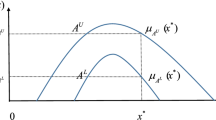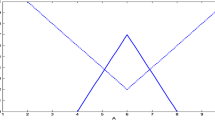Abstract
In the past, lots of multi-criteria decision-making (MCDM) methods included simple additive weighting (SAW) extended under fuzzy environment into multi-criteria decision-making (FMCDM) methods to encompass uncertainty and vagueness of data. The extensions were first used in FMCDM with independent evaluation criteria, and then, FMCDM could be associated with quality function deployment (QFD) to break the tie of dependent evaluation criteria. Commonly, alternative ratings and criteria weights in FMCDM were expressed by general fuzzy numbers (i.e., triangular or trapezoidal fuzzy numbers). Recently, some approaches proposed FMCDM with independent evaluation criteria under interval-valued fuzzy environment. For interval-valued fuzzy numbers, FMCDM with dependent evaluation criteria was scarcely elaborated due to computation complexity. Besides, QFD was also generalized under some fuzzy environments consisting of triangular fuzzy numbers or trapezoidal fuzzy numbers, but not interval-valued fuzzy environment. Practically, interval-valued fuzzy numbers are deemed as a kind of fuzzy number that can grasp more information than other fuzzy numbers, but the kind of fuzzy number is more complex on computation than others. Based on above, we desire to extend QFD and SAW under interval-valued fuzzy environment for FMCDM with dependent evaluation criteria. By a rational technique of combining QFD with SAW under fuzzy environment, the computation tie of interval-valued fuzzy numbers corresponding to dependent evaluation criteria is resolved, and more messages are grasped than using other fuzzy numbers in FMCDM.



Similar content being viewed by others
References
Ashtiani A, Haghighirad F, Makui A, Montazer GA (2009) Extension of fuzzy TOPSIS method based on interval-valued fuzzy sets. Appl Soft Comput 9:457–461
Bellman RE, Zadeh LA (1970) Decision-making in a fuzzy environment. Manag Sci 17:141–164
Chan LK, Wu ML (2002) Quality function deployment: a literature review. Eur J Oper Res 143:463–497
Chen CT (2000) Extensions to the TOPSIS for group decision-making under fuzzy environment. Fuzzy Sets Syst 114:1–9
Chen TY (2011) Interval-valued fuzzy TOPSIS method with leniency reduction and an experimental analysis. Expert Syst Appl 11:4591–4608
Chen SJ, Hwang CL (1992) Fuzzy multiple attribute decision making: methods and applications. Springer, New York
Chen LH, Ko WC (2009) Fuzzy approaches to quality function deployment for new product design. Fuzzy Sets Syst 160:2620–2639
Churchman CW, Ackoff RJ, Amoff EL (1957) Introduction to operation research. Wiley, New York
Delgado M, Verdegay JL, Vila MA (1992) Linguistic decision-making models. Int J Intell Syst 7:479–492
Epp SS (1990) Discrete mathematics with applications. Wadsworth, Belmont
Fan ZP, Ma J, Zhang Q (2002) An approach to multiple attribute decision making based on fuzzy preference information on alternatives. Fuzzy Sets Syst 131:101–106
Gorzalczany MB (1987) A method of inference in approximate reasoning based on interval-valued fuzzy sets. Fuzzy Sets Syst 21:1–17
Herrera F, Herrera-Viedma E, Verdegay JL (1996) A model of consensus in group decision making under linguistic assessments. Fuzzy Sets Syst 78:73–87
Hwang CL, Yoon K (1981) Multiple attribute decision making: methods and applications. Springer, New York
Jain R (1978) A procedure for multi-aspect decision making using fuzzy sets. Int J Syst Sci 8:1–7
Joshi D, Kumar S (2016) Interval-valued intuitionistic hesitant fuzzy Choquet integral based TOPSIS method for multi-criteria group decision making. Eur J Oper Res 248:183–191
Kacprzyk J, Fedrizzi M, Nurmi H (1992) Group decision making and consensus under fuzzy preferences and fuzzy majority. Fuzzy Sets Syst 49:21–31
Keeney R, Raiffa H (1976) Decision with multiple objective: preference and value tradeoffs. Wiley, New Work
Kuo MS, Liang GS (2012) A soft computing method of performance evaluation with MCDM based on interval-valued fuzzy numbers. Appl Soft Comput 12:476–485
Kuo TC, Wu HH, Shieh JI (2009) Integration of environmental considerations in quality function deployment by using fuzzy logic. Expert Syst Appl 36:7148–7156
Lee HS (2005a) A fuzzy multi-criteria decision making model for the selection of the distribution center. Lect Notes Artif Intell 3612:1290–1299
Lee HS (2005b) On fuzzy preference relation in group decision making. Int J Comput Math 82:133–140
Lee CS, Chung CC, Lee HS, Gan GY, Chou MT (2016) An interval-valued fuzzy number approach for supplier selection. J Mar Sci Tech-Taiw 24:384–389
Li RJ (1999) Fuzzy method in group decision making. Comput Math Appl 38:91–101
Liang GS (1999) Fuzzy MCDM based on ideal and anti-ideal concepts. Eur J Oper Res 112:682–691
Liang GS (2010) Applying fuzzy quality function deployment to identify service management requirements. Qual Quant 44:47–57
Liang GS, Wang MJ (1991) A fuzzy multi-criteria decision-making method for facility site selection. Int J Prod Res 29:2313–2330
Lin LZ, Chen WC, Chang TJ (2011) Using FQFD to analyze island accommodation management in fuzzy linguistic preferences. Expert Syst Appl 38:7738–7745
Lin LZ, Yeh HR, Wang MC (2015) Integration of Kano’s model into FQFD for Taiwanese Ban-Doh banquet culture. Tour Manag 46:245–262
Liu F, Zhang WG, Fu JH (2012) A new method of obtaining the priority weights from an interval fuzzy preference relation. Inf Sci 185:32–42
Lowe A, Ridgway K, Atkinson H (2000) QFD in new production technology evaluation. Int J Prod Econ 67:103–112
Matook S, Indulska M (2009) Improving the quality of process reference models: a quality function deployment-based approach. Decis Support Syst 47:60–71
Modarres M, Sadi-Nezhad S (2005) Fuzzy simple additive weighting method by preference ratio. Intell Autom Soft Co 11:235–244
Mokhtarian MN (2015) A note on “Extension of fuzzy TOPSIS method based on interval-valued fuzzy sets”. Appl Soft Comput 26:513–514
Nakamura K (1986) Preference relations on a set of fuzzy utilities as a basis for decision making. Fuzzy Sets Syst 20:147–162
Partovi FY, Corredoira RA (2002) Quality function deployment for the good of soccer. Eur J Oper Res 137:642–656
Raj PA, Kumar DN (1999) Ranking alternatives with fuzzy weights using maximizing set and minimizing set. Fuzzy Sets Syst 105:365–375
Rashid T, Beg I, Husnine SM (2014) Robot selection by using generalized interval-valued fuzzy numbers with TOPSIS. Appl Soft Comput 21:462–468
Tanino T (1984) Fuzzy preference in group decision making. Fuzzy Sets Syst 12:117–131
Vahdani B, Tavakkoli-Moghaddam R, Mousavi SM, Ghodratnama A (2013) Soft computing based on new interval-valued fuzzy modified multi-criteria decision-making method. Appl Soft Comput 13:165–172
Wang YJ (2014) A criteria weighting approach by combining fuzzy quality function deployment with relative preference relation. Appl Soft Comput 14:419–430
Wang YJ (2015) A fuzzy multi-criteria decision-making model based on simple additive weighting method and relative preference relation. Appl Soft Comput 30:412–420
Wang YJ (2016) Applying FQFD and utility representative functions under fuzzy environment for FMCDM. J Test Eval 44:1776–1790
Wang CY, Chen SM (2017) Multiple attribute decision making based on interval-valued intuitionistic fuzzy sets, linear programming methodology, and the extended TOPSIS method. Inf Sci 397–398:155–167
Yao JS, Lin FT (2002) Constructing a fuzzy flow-shop sequencing model based on statistical data. Int J Approx Reason 29:215–234
Zadeh LA (1965) Fuzzy sets. Inf Control 8:338–353
Acknowledgements
This research work was partially supported by the Ministry of Science and Technology of the Republic of China under Grant No. MOST 106-2410-H-346-002.
Author information
Authors and Affiliations
Corresponding author
Ethics declarations
Conflict of interest
Author declares that there is no conflict of interest.
Ethical approval
This article does not contain any studies with human participants or animals performed by the author.
Informed consent
Based on above, “Informed consent” is unnecessary.
Additional information
Communicated by V. Loia.
Publisher's Note
Springer Nature remains neutral with regard to jurisdictional claims in published maps and institutional affiliations.
Rights and permissions
About this article
Cite this article
Wang, YJ. Combining quality function deployment with simple additive weighting for interval-valued fuzzy multi-criteria decision-making with dependent evaluation criteria. Soft Comput 24, 7757–7767 (2020). https://doi.org/10.1007/s00500-019-04394-5
Published:
Issue Date:
DOI: https://doi.org/10.1007/s00500-019-04394-5




